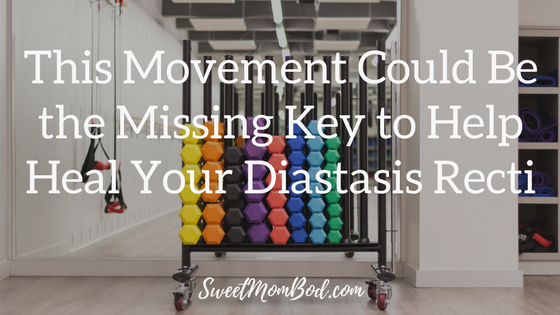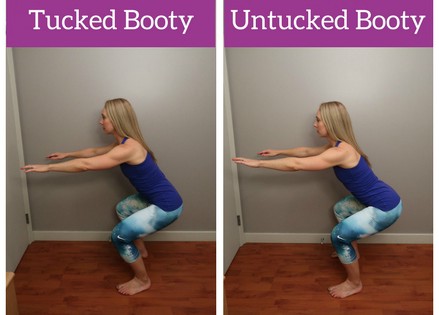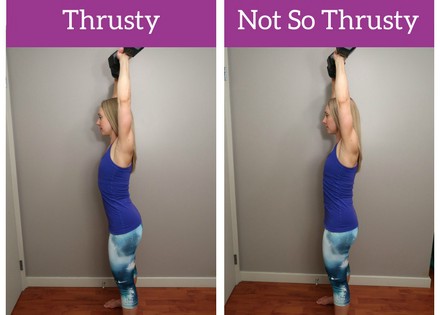
When you search for “diastasis safe exercises” it seems like everyone and their poodle has an idea of what you should do and what you – “Oh my goodness don’t even think about it or you’ll never heal!” – definitely shouldn’t do.
Healing a diastasis can feel overwhelming and exhausting – especially with so many ideas floating around out there.
The problem is, there isn’t one best strategy for every single mama.
I wish I could just say, “Go do these 5 exercises twice a day and you’ll be healed in 6 weeks!”
But it’s not that magical.
Every body is different. Every case is different.
Which is why I can’t promise you that what you’ll learn in today’s post will absolutely heal your fascia and tissues and give you 100% function and strength back.
But what I can promise is that I’ll let you in on some must-know goodness that’ll help you better manage your diastasis and increase your chances of actually healing it.
If you’ve been doing some research on diastasis recti (DR), you may already know what kinds of exercises you want to avoid – especially while you’re in the beginning stages of healing your separation. Things like:
- Traditional ab exercises – crunches, sit-ups, V ups, bicycle crunches, or boat pose.
- Heavy, or intense overhead work – pull-ups (especially unassisted) and heavy overhead presses (especially from standing).
- Things that can put aggressive pressure on your core and pelvic floor – burpees, I’m looking at you!
But remember, it’s not just about the exercises you’re doing. It’s also about how you’re doing them.
Honestly, almost any exercise can be “diastasis safe”, or “unsafe” depending on what you’re doing during the movement.
It’s really more about how you do it – your strategy. Not necessarily what you’re doing.
There are certain strategies that can help you heal (and others that can slow down your healing process).
There are all kinds of things that can impact how quickly and easily your linea alba recovers (the linea alba is the line of connective tissue that runs down the center of your abs separating the two sides of your rectus abdominis/”6 pack”. This is what stretches and expands as your pregnancy progresses and what we want to help heal and rehab postpartum). Things like how you…
- Breathe
- Sit, stand, walk or run
- Engage your core
- Stack your body bits on top of one another (the fancy term for that is alignment 🙂 )
So I want to make it Windexed window levels of clear – just doing corrective or rehabilitative exercises may not be enough to fully heal your DR.
There are so many lifestyle factors that come out to play too. So we need to keep those in mind and not be so focused on finding the holy grail of exercise that is going to heal all the diastasis.
Integrating the lifestyle bits with the core restoring exercises is the magical mix that will give you the best chances of gaining back as much function as possible.
So. With that in mind. As you’re working out (and honestly in your every day life) you’re going to want to avoid:
1. Holding your breath as you move – even for a moment. You might even find you breathe well during workouts, but then hold your breath while you’re picking up your kiddo. This puts unfriendly pressure on your core and pelvic floor and will definitely make healing your diastasis a lot more challenging. So exhale on any exertion (even if you’re simply picking a crumb up off the floor – exhale as you come back up to standing).
2. Tucking your booty. A posterior pelvic tilt is a habit you’re gonna wanna get out of – especially as you’re working on healing your diastasis. Strong glutes are crucial to a well functioning core and pelvic floor and it’s hard to activate and strengthen your glutes if you’re hiding them.
3. Thrusting your ribs up or flaring your ribcage. In order to properly engage and work your core, your ribs need to be stacked over top of your pelvis. So – without gripping your upper abs – drop those ribs so you can allow your diaphragm, transverse abdominis, and pelvic floor to all work together in happy harmony to help strengthen your core and close that gap.
And let’s be clear – it’s not just about the exercises you do, but what stretches you do as well.
Yes. Make that a trifecta of magical mix – lifestyle changes + exercises + stretches.
Think about it. Diastasis literally means “an abnormal separation of parts normally joined together“. So if you’ve got two sides of your rectus abdominis that are normally supposed to be closer together, wouldn’t it make sense that any tight muscles that are pulling on your abs could make healing your diastasis challenging (maybe even impossible)?
So we need long muscles that aren’t pulling on your abs and keeping that gap open; because even a tight shoulder can impact your abs. Crazy. I know. But true.
This means that the big take-home message I want you to run with is that it’s not just about doing specific exercises (like 50 heel slides a day).
There’s actually a Magical Mix Trifecta: Lifestyle + Exercise + Stretching. These are the 3 essential ingredients we need to regain function and strength and have awesome abs.
If we ignore one, it’s like baking a cake without flour. It might taste like weirdly okay chocolate soup, but it’s just not giving us exactly what we want.
And now the truth.
Remember the whole “there’s no one size fits all moms” prescription to heal your DR?
Right. Okay. So you may have been told to avoid a certain movement because it’s “bad” for diastasis, or could make your separation worse. But it may actually be the missing link to help you get full function and strength back to your core.
That movement?
Rotation.
Some coaches and trainers believe you shouldn’t do any rotational exercises when you have diastasis because they think rotating could put too much pressure on the diastasis – potentially encouraging it to stay open, instead of closing. Which may be true – for some people, with some exercises (especially if those people aren’t using the right strategies or methods as they’re doing the exercises).
Remember – there’s no one best way to heal diastasis. What’s true for some is false for others. And you may also recall that thing I said about how really any exercise can be “safe” or “not safe” for diastasis.
In the smart words of The Physio Detective, Antony Lo – “It’s not what you do. It’s how you do it.”
Now I’m not about to suggest you go do 100 bicycle crunches a day to heal your diastasis. I’m not (yet) convinced that is the best plan.
But what I do know is that you do a ton of rotational movements throughout the day.
- Putting the carseat in the car.
- Taking the carseat out of the car.
- Putting your kiddo in the carseat.
- Taking your kiddo out of the carseat.
- Pulling groceries out of the bag and putting them in your fridge or cupboard.
- Grabbing a snack off the counter and handing it to your kid.
- Opening and closing doors.
- Getting into and out of bed.
- Reaching beside you for your tea (or wine. No judgment. 😉 ) while you’re watching TV.
- Turning to the side to kiss your kiddo’s cheek to get the perfect #MommyAndMe selfie.
- You get the point, right?
So avoiding working on rotational movements during your workouts if you have diastasis is honestly silly since rotation is a huge part of your everyday life.
And if you aren’t feeling strong and confident while you’re rotating, your body won’t be able to respond as well during those daily rotation actions and you’ll be worried about ruining everything and making your diastasis so much worse (sometimes the mental stuff is just as important as the physical stuff when it comes to helping our bodies heal).
This means that maybe the best thing you can do is:
- Help your body get stronger and better at rotating by doing smart rotational exercises effectively.
- Stretch the muscles that need to be long to help make that rotation happen without pulling on your abs – remember we want to make sure that nothing could be impacting our chances of healing – including tight muscles that are pulling all day, every day (especially when we move).
Now here’s the fine print, read before you buy note: I wouldn’t start with rotational exercises from day one. If you’re just starting on your diastasis healing journey, or you still have a pretty significant wide and deep gap and a line alba that’s still totally on vacation, I would start with some other movements first (like body weight squats and these kinds of core-focused exercises).
Then, once your linea alba is responding better, and you’re feeling stronger in your core, you can dive into some rotation fun!
Start slow. Start small. Start with super light weight (or just your bodyweight) and work up to heavier loads and overtime you’ll get stronger, and stronger.
Here are some options to help get you started.
Of course I can’t just say “go do some rotation exercises” and leave it at that. Which is why I’m giving you some basics to start with.
These may seem simple and easy and, “Why am I doing this, can’t I just go lift all the things?!”
I hear you. I hear that you’d much rather do a deadlift or something than try these guys out. And you can absolutely include deadlifts as part of your postpartum recovery plan if that’s what works for your body.
But the truth is that, as much as you may want to just dive in and go hard, the fact that you’ve made it this far into the post tells me 2 things:
- You have diastasis and you want it to heal.
- You’ve probably tried some other stuff and maybe it’s not working as well as you’d hope so you’re looking for other options.
So yes. Absolutely. You for sure can go lift all the things and skip out on these guys. But the truth is that the foundational work I do with moms – from breathing, to alignment, to basic exercises like these – are what help stop them from getting injured, help make sure they don’t have to deal with any issues (like incontinence) and ensure they actually feel strong and confident when they do go to lift all the things.
The choice is yours.
I will simply leave you with the fact that this is where I started too and I’m so glad I did these exercises because now I can press heavy weights over my head again without any pain in my back or feeling like my core is just not going to keep it together (and so many more movements and fun stuff).
Remember the crucial cues.
As you’re doing these exercises, you shouldn’t feel any aggressive pulling in your abs or see any doming or bulging. You’ll feel your core work, but it shouldn’t hurt and it shouldn’t feel like your ab muscles are ripping apart or anything traumatic like that.
Also, choose a really light weight band to begin with – or just do a body weight rotation to start – and slowly work your way up to heavier loads.
Bonus tip: If you’re working with a trainer, get them to feel your core (not just your linea alba, your entire core) as you’re doing the movements to check in with what your linea alba is doing and how your diastasis is responding.
With all of the movements you want to focus on some key cues:
1. Make sure your butt stays untucked and your pelvis doesn’t start pushing forward.
2. Exhale and engage your core as you rotate. Inhale on the way back to the starting position.
3. Keep your arms straight so you feel it more in your core and not so much in your arms.
4. Have your ribs stacked over top of your hips – this will ensure your entire core system (including your diaphragm, transverse abdominis, and pelvic floor) can work in coordination with each other (which is key to helping heal your diastasis).
5. Do all your reps on one side then turn around and do all your reps on the other side. (P.S. It’s not uncommon to feel stronger on one side – especially if you’re used to carrying your kiddo – or all your kiddo’s stuff – on one side all the time. Side note: Avery loves my right side. If I try to carry her on my left she monkey climbs her way over to my right. So I hear you. Sometimes it’s just life that your one side gets more of the daily work).
Half Kneeling Low to High Band Chops
Half Kneeling Chest Height Band Chops
Half Kneeling High to Low Band Chops
Half Kneeling Weighted Chop
Remember the Magical Trifecta.
Healing your diastasis can feel overwhelming and impossible – especially when you feel like you’ve tried everything.
But it doesn’t have to be.
Having a diastasis is a totally normal part of pregnancy and the truth is your body wants to heal and get strong again. You simply need to give it some helpful nudges with the right strategies and tools.
Remember – it’s not just about the exercises you’re doing, it’s how you’re doing them and what you’re doing the other 20+ hours of the day.
You can do “diastasis safe” exercises until you can’t even look at the word “clams” on a menu you’re so sick of clamshells. But if you aren’t working on the other key elements, you’re going to have a much harder time getting the results you’re hoping for.
So work on proper breathing, optimal alignment, effective core engagement, stretching and working on your flexibility in your entire body and plain ol’ relaxing your core muscles.
It all adds up and it all helps give you the strong, capable core you’re searching for.
Does this mean you need to be perfectly breathing, perfectly aligned, perfectly engaged, perfectly limber, perfectly perfect at all times?
Hell no.
I simply want you to be conscious of these things as much as possible. And slowly, overtime it’ll become second nature to be in better alignment and exhale whenever you’re doing something somewhat exertion-y.
This post isn’t meant to add to the “scare the pants off you” pile of online advice about DR.
I hope it’s given you some support and ideas of what may work for you.
You don’t have to be scared to try something just because you have diastasis.
With the right strategies and the right approach, you can (and will) have a strong core again.
How do I know?
Because – before I became a postnatal fitness pro – I had a 4+ finger-width diastasis months after giving birth, my back ached, my belly pooched and I couldn’t hold even a light weight above my head without worrying my core was going to give out on me.
Now I feel just as strong (if not stronger) than I did before I had my daughter.
It’s cliche but true. I healed and I’m pretty darn positive that – if you choose to take some strategic steps – you can too.
So have at ‘er, my friend.
Hugs,
Jen
P.S. Did you like this post? If you did, please share it with your mom friends. And if you want even more awesome core exercises to add to your life, be sure to subscribe by popping your name and email into the box below.
Thank you 😊
You’re so welcome, Christine 🙂
Thanks would love to hear more
Absolutely, Belinda! You can check out more posts about diastasis right here: https://jennadalton.com/tips-strategies-to-help-heal-better-manage-diastasis-recti-prolapse-incontinence-other-common-postnatal-issues/
Enjoy and post a comment under the post if you have any questions 🙂
Hello!
I love this info, thank you! My last c-section was 10 years ago and I ended up with diastasis recti and a hernia in my button belly. My obgyn never care so much about it and said I was doing great. I never wear any waist trainer or wrap to help with it. If I bend backwards it measures like 4 fingers. I’m 44 now and I have started to work out and do sit ups and lift weights. Can my diastasis recti be healed still? Should I be doing lifting?
Thank you for you help!
Talita
Hi Talita, Yes, it’s never too late to help heal your diastasis. With the right program and approach you can build your strength and function back. You can also still do weight training with diastasis, we simply want to focus on the right alignment and breathing strategies to avoid exacerbating the problem.